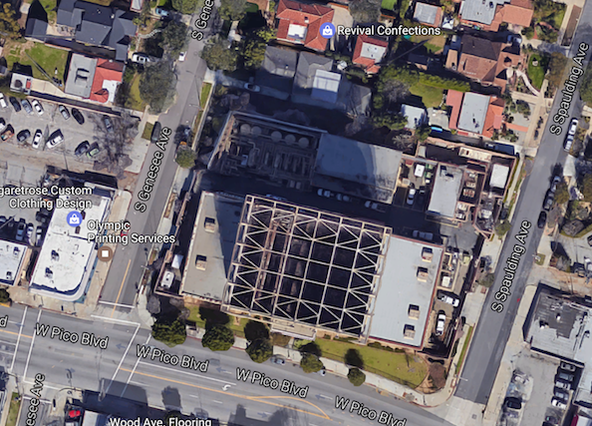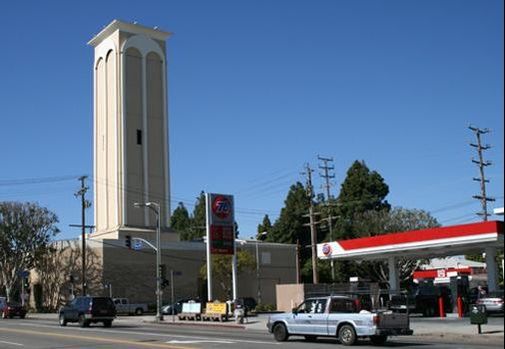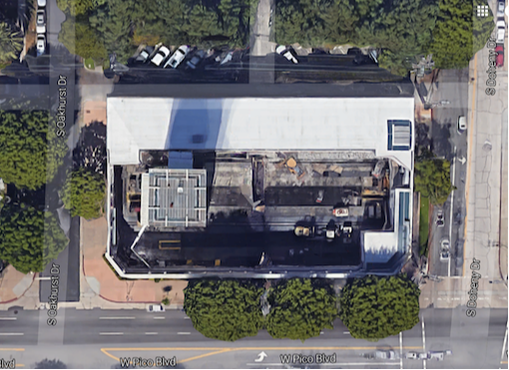PICO BLVD. DRILL SITES
On one of the busiest throughways in Los Angeles, the oil industry hides two active oil wells in plain sight.
|
Packard Well Site: 5733 W. Pico Blvd., Los Angeles, CA
WELL COUNT: 51 total active wells COMPANY: Freeport-McMoRan DISTANCE FROM HOMES: 125 feet Despite its suspicious lack of windows and a roof, Packard Drill Site can fool the casual bystander into thinking that it is just another office on the 5700 block of Pico Blvd. |
 Via Google Maps
Via Google Maps
When it was first built in 1968, Packard Drill Site was open and welcome to the public. Angelenos were invited to enter the building to view an educational display in the lobby and even observe the operations of the pumps. As attitudes about oil and gas development have changed over the years, the public has been barred from the grounds by a locked fence.
Within the roofless structure, an oil derrick moves freely around on tracks, able to shift between any of the existing 51 wells. Packard Drill Site continues to produce thousands of barrels of oil each year, while unsuspecting Angelenos drive by, oblivious.
Within the roofless structure, an oil derrick moves freely around on tracks, able to shift between any of the existing 51 wells. Packard Drill Site continues to produce thousands of barrels of oil each year, while unsuspecting Angelenos drive by, oblivious.
CARDIFF TOWER DRILL SITE
|
Cardiff Tower: 9101 Pico Blvd., Los Angeles, CA WELL COUNT: 40 active wells. COMPANY: Pacific Coast Energy Company LP DISTANCE FROM HOMES: 100 feet |
 Via Center for Land Use Interpretation
Via Center for Land Use Interpretation
In Pico-Robertson, nestled in the heart of an Orthodox Jewish neighborhood, the Cardiff Tower oil well quietly pumps oil from the ground behind thick, windowless walls. Despite the fact that the 175-foot tower looms over the neighborhood, Cardiff Tower blends inconspicuously into the background. The structure was intentionally designed to resemble a synagogue tower so as to not alarm its neighbors, which include a pre-school, a synagogue, and homes.
Cardiff Tower was originally built in 1966 by Occidental Petroleum and was lauded as the first “architecturally designed oil derrick.” The Mayor of Los Angeles at the time, Sam Yorty, even attended the ribbon cutting ceremony, praising it as “an outstanding contribution to civic beauty.” However, the aesthetics of the tower belie the aggressive drilling taking place within its walls.
 An aerial view of the open-air structure (via Google Maps)
An aerial view of the open-air structure (via Google Maps)
In 1998, it was sold to Breitburn Energy, a company which specializes in buying aging wells and then ramping up oil extraction. Breitburn Energy quickly set about reconfiguring Cardiff Tower to accommodate increased production.
Despite heavy criticism from community groups, Breitburn pressed on. In return for permission to drill 24/7 year-round, Breitburn replaced the old diesel rig with an electric one, extended the height of the tower to enclose said rig, and expanded the thickness of the building’s walls from 12 feet to 25 feet.
However, the same protections of this community are not extended to communities in South Los Angeles. While Breitburn carried out expensive modifications to lessen (but not completely eliminate) the noise and pollution harms emanating from the site, frontline communities in under-resourced neighborhoods are denied similar protections daily to shield them from the light, noise, and air pollution caused by oil drilling.
Despite heavy criticism from community groups, Breitburn pressed on. In return for permission to drill 24/7 year-round, Breitburn replaced the old diesel rig with an electric one, extended the height of the tower to enclose said rig, and expanded the thickness of the building’s walls from 12 feet to 25 feet.
However, the same protections of this community are not extended to communities in South Los Angeles. While Breitburn carried out expensive modifications to lessen (but not completely eliminate) the noise and pollution harms emanating from the site, frontline communities in under-resourced neighborhoods are denied similar protections daily to shield them from the light, noise, and air pollution caused by oil drilling.